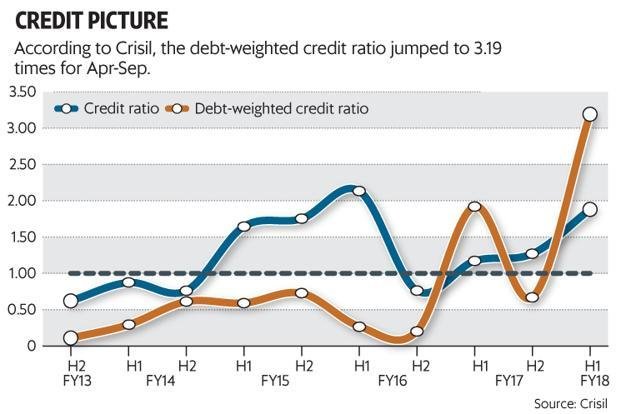
According to Crisil Ratings, the debt-weighted credit ratio jumped to 3.19 times for the first half of fiscal 2018 compared to 1.92 times a year ago. Debt-weighted credit ratio refers to ratio of upgrades to downgrades weighted by the quantity of debt.
The regular credit ratio—i.e. the number of upgrades to downgrades—also improved to 1.88 times this fiscal, showing an improvement in credit quality.
On the other hand, Icra Ltd said that the debt-weighted credit ratio of the entities it rates fell to one time in the first half of fiscal 2018 compared to 1.7 times in fiscal 2017. This is “indicative of the continuing pressures on credit quality,” the ratings company said.
To be sure, the numbers may not be entirely comparable. Icra has made a total of 565 ratings changes in the first half of the current fiscal compared to 1,251 for Crisil.
Read More: Rupee Strengthens against US Dollar ahead of RBI Policy
he sectoral composition of these ratings may also differ.
Icra’s debt-weighted ratio also excludes the top 5% of the sharpest ratings changes. Crisil said that the credit ratios have seen an improvement on a 12-month rolling basis also showing that it is sustainable and free of “period bias”.
- 1 Pawan Agrawal, chief analytical officer at Crisil Ratings, said improvement in credit quality was primarily because of better financial indicators as companies kept away from capital expenditure given substantial headroom in capacity utilization in many sectors. He expects this trend to continue till demand firms up while lower interest costs will provide further support.
- 2 Rating agencies give contrasting views on Indian firms’ credit quality | Neal Bhai Reports | Gold Silver Reports
Pawan Agrawal, chief analytical officer at Crisil Ratings, said improvement in credit quality was primarily because of better financial indicators as companies kept away from capital expenditure given substantial headroom in capacity utilization in many sectors. He expects this trend to continue till demand firms up while lower interest costs will provide further support.
Icra pointed out that it downgraded Rs2.9 trillion worth of debt in the first half of this fiscal, higher than the amount downgraded over the entire fiscal 2017. Ferrous metals, banking and finance and telecom were some select sectors where the number of downgrades was higher than upgrades.
“In fiscal 2017, in the non-financial sector, the top 10 percentile of entities downgraded accounted for around 50% of the total debt downgraded. This figure stood much lower at around 30% in the first half of financial year 2018, signifying that credit quality pressures have become relatively more widespread, and are not just restricted to a limited set of entities,” said Jitin Makkar, head of credit policy at Icra.
The contrasting data comes at a time when the Indian economy is plagued with the twin balance sheet problem of bad loans and overleveraged firms. Corporate earnings are also far away from a recovery while Indian banks are sitting on stressed loans of over Rs10 trillion.
Bankers said that while most of the stressed loans are due to legacy problem of slowdown in the previous years, the trend on credit ratio depends on the resolution as well as revival of the sluggish private sector investment.
“Some firms, especially small sized ones, continue to face headwinds of demonetisation. Additionally, as they adjust to GST (goods and services tax), the cash flows are disruptive, which is reflecting delayed loan repayments. Resolution of stressed loans is one of the key components that will help revive GDP (gross domestic product) growth,” said a senior banker with a large Mumbai-based bank, requesting anonymity.

Comments are closed.